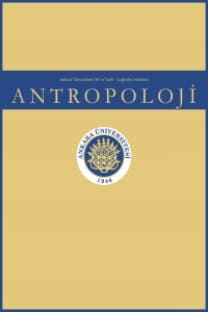KÜLTÜR, GÜNDELİK HAYAT VE TEATRALLİK İLİŞKİSİ AÇISINDAN PERFORMANS ANTROPOLOJİSİ
Sosyal antropolojinin sembolik ve yorumsamacı yaklaşımından hareket edip,sosyolojinin sembolik etkileşimci ve dramaturjik yaklaşımından beslenenperformans antropolojisi, gündelik hayatta farklı kültür temsilleriniyorumlayabilmek için, güncel, yenilikçi ve özgün bir kuramsal çerçeve sunmaktadır.Buradan hareketle bu çalışma, performans antropolojisi alanının teorik arkaplanını, temel konularını, sorunlarını, metodolojisini ve sınırlarını ortaya koymayıhedeflemektedir. Esasen sahne ve gösteri sanatları alanı ile ilgili olan performansteriminin, neden ve hangi açılardan antropolojik yaklaşım çerçevesine girip kültürtemsillerinin değerlendirilmesinde anlamlı bir kavram haline geldiğininsorgulanması makalenin ana amacıdır. Bu doğrultuda literatür taraması yöntemikullanılan bu makalenin ilk aşamasında, sırasıyla Victor Turner’ın performansantropolojisi alanının belkemiğini oluşturan kavramları, Richard Schechner’ıngünümüz dünyasında teatralliğin gündelik hayata nüfuzu üzerinden geliştirdiğiperformans teorisi ile Erving Goffman’ın dramaturjik yaklaşımı ayrıntılı olarakincelenmiştir. Ardından, toplumsal gerçekliğin inşasında performativite kavramıirdelenmiştir. Son olarak, bu alanın hangi açılardan performans sosyolojisiyleörtüştüğü değerlendirilmiştir. İncelemeler sonucu, performans terimi, küreselleşendünyanın yeni iletişim teknolojileriyle birbiri içine geçmiş bulunan yapısı içinde,gündelik hayatta farklı toplumsal alanlarda, eskisinden daha kırılgan ve muğlak birkarakter kazanmış olan kimlik ve kültür örüntülerinin, temsil edilen, sergilenen,etkileşimli ve edimsel yapısını açıklamak için etkin ve anlamlı bir kavram olarakaçığa çıkmıştır.
Anthropology of Performance in terms of Culture, Everyday Life and Theatricality
Sourcing from the symbolic and interpretive approach of social anthropology and fostered by the symbolic interactionism and dramaturgical approach of sociology, anthropology of performance presents today an innovative and genuine theoretical framework for the interpretation of diverse cultural representations in everyday life. This paper thus aims to put forward the theoretical background, fundamentals, main issues, methodology, and boundaries of anthropology of performance. The main objective of this study is to question the reasons and aspects of the appropriation of a formerly stage and performing arts term by the discipline of anthropology to evaluate the representations of culture. Using the literature review methodology, this study in the first place examines thoroughly the concepts of Turner, who in fact constituted the grounds of anthropology of performance, followed by Schechner’s performance theory that inserts theatricality to everyday life, and the dramaturgical approach of Goffman. Secondly, the concept of performativity was analyzed within the construction of social reality. The article finally gravitates towards a comparative analysis between this discipline and sociology of performance. This study concludes that the concept of performance reveals as an effective and comprehensive term for the interpretation of identity and culture patterns, which have become more fragile and ambiguous than before amidst globalization and new information technologies, which are continuously represented and displayed in an interactional way in everyday life throughout different social milieu.
___
- Austin, J. L. (1975). How to Do Things with Words, Cambridge, Massachusetts: Harvard University Press.
- Bateson, G. (1987). Steps to an Ecology of Mind: Collected Essays in Anthropology, Psychiatry, Evolution and Epistemology, Northvale: Jason Aronson.
- Butler, J. (1988). Performative Acts and Gender Constitution: An Essay in Phenomenology and Feminist Theory, Theater Journal 40(4), 519-531.
- Cooley, C.H. (1902). Human Nature and The Social Order, New York: Charles Scribner’s Sons.
- Goffman, E. (1973). Presentation of Self in Everyday Life, New York: The Overlook Press.
- Huizinga, J. (1950). “The Nature and Significance of Play as a Cultural Phenomenon”, The Performance Studies Reader, H. Bial (Ed.). London: Routledge, 117-121.
- Lacan, J. (1949). “The Mirror Stage as Formative of the Function of the I as Revealed in Psychoanalytic Experience”. The Norton Anthology of Theory and Criticism, Vincent B. Leitch et al. (Eds.). New York: W. W. Norton & Company.
- Mead, G.H. (1934). Mind, Self, and Society, Chicago: The University of Chicago Press.
- Murphy, P. (2012). Class and Performance in the Age of Global Capitalism, Theatre Research International 37(1), 49–62.
- Parker, A. and Sedgwick, K. (2004). “Introduction to performativity and performance”. The Performance Studies Reader, H. Bial (Ed.). London: Routledge, 167-175.
- Schechner, R. (2002). Performance Studies, An Introduction, London: Routledge.
- Simpson, P. (2011). Street performance and the city: Public space, sociality, and intervening in the everyday, Space and Culture 14(4), 415-430.
- Turner, V. (2007). The Ritual Process: Structure and Anti-structure, NJ New Burnswick: Aldine Transaction.
- Turner, V. (1988). The Anthropology of Performance, New York: PAJ Publications.
- Turner, V. (1980). Social Dramas and Stories About Them, Critical Inquiry 7(1), 141-168.
- Turner, V. (1969). “Liminality and Communitas”. The Performance Studies Reader, H. Bial (ed.). London: Routledge, 79-87.
- ISSN: 0378-2891
- Yayın Aralığı: Yılda 2 Sayı
- Başlangıç: 1963
- Yayıncı: Ankara Üniversitesi Basımevi
Sayıdaki Diğer Makaleler
PELVİS’TEN RADYOLOJİK YÖNTEMLER İLE CİNSİYET TAYİNİ: TÜRKİYE ÖRNEKLEMİ
KÜLTÜR, GÜNDELİK HAYAT VE TEATRALLİK İLİŞKİSİ AÇISINDAN PERFORMANS ANTROPOLOJİSİ
TÜRK KÜLTÜRÜNDE BİR KORKU KÜLTÜ OLARAK SİVAS’TA ALKARISI VE ALBASMASI İNANIŞI
LAURA ESQUİVEL’İN ACI ÇİKOLATA ROMANI ÜZERİNDEN DUYGUSAL DÜNYA VE YEMEK KÜLTÜRÜ İLİŞKİSİ
